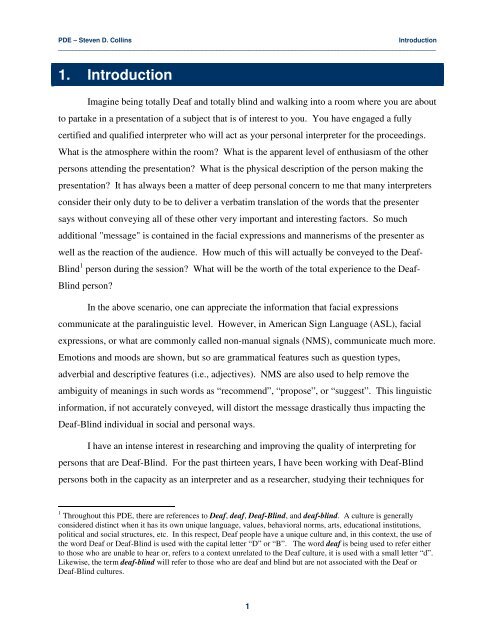Adverbial Morphemes in Tactile ASL - Gallaudet University
Adverbial Morphemes in Tactile ASL - Gallaudet University
Adverbial Morphemes in Tactile ASL - Gallaudet University
Create successful ePaper yourself
Turn your PDF publications into a flip-book with our unique Google optimized e-Paper software.
PDE – Steven D. Coll<strong>in</strong>s<br />
Introduction<br />
_________________________________________________________________________________________________________<br />
1. Introduction<br />
Imag<strong>in</strong>e be<strong>in</strong>g totally Deaf and totally bl<strong>in</strong>d and walk<strong>in</strong>g <strong>in</strong>to a room where you are about<br />
to partake <strong>in</strong> a presentation of a subject that is of <strong>in</strong>terest to you. You have engaged a fully<br />
certified and qualified <strong>in</strong>terpreter who will act as your personal <strong>in</strong>terpreter for the proceed<strong>in</strong>gs.<br />
What is the atmosphere with<strong>in</strong> the room? What is the apparent level of enthusiasm of the other<br />
persons attend<strong>in</strong>g the presentation? What is the physical description of the person mak<strong>in</strong>g the<br />
presentation? It has always been a matter of deep personal concern to me that many <strong>in</strong>terpreters<br />
consider their only duty to be to deliver a verbatim translation of the words that the presenter<br />
says without convey<strong>in</strong>g all of these other very important and <strong>in</strong>terest<strong>in</strong>g factors. So much<br />
additional "message" is conta<strong>in</strong>ed <strong>in</strong> the facial expressions and mannerisms of the presenter as<br />
well as the reaction of the audience. How much of this will actually be conveyed to the Deaf-<br />
Bl<strong>in</strong>d 1 person dur<strong>in</strong>g the session? What will be the worth of the total experience to the Deaf-<br />
Bl<strong>in</strong>d person?<br />
In the above scenario, one can appreciate the <strong>in</strong>formation that facial expressions<br />
communicate at the paral<strong>in</strong>guistic level. However, <strong>in</strong> American Sign Language (<strong>ASL</strong>), facial<br />
expressions, or what are commonly called non-manual signals (NMS), communicate much more.<br />
Emotions and moods are shown, but so are grammatical features such as question types,<br />
adverbial and descriptive features (i.e., adjectives). NMS are also used to help remove the<br />
ambiguity of mean<strong>in</strong>gs <strong>in</strong> such words as “recommend”, “propose”, or “suggest”. This l<strong>in</strong>guistic<br />
<strong>in</strong>formation, if not accurately conveyed, will distort the message drastically thus impact<strong>in</strong>g the<br />
Deaf-Bl<strong>in</strong>d <strong>in</strong>dividual <strong>in</strong> social and personal ways.<br />
I have an <strong>in</strong>tense <strong>in</strong>terest <strong>in</strong> research<strong>in</strong>g and improv<strong>in</strong>g the quality of <strong>in</strong>terpret<strong>in</strong>g for<br />
persons that are Deaf-Bl<strong>in</strong>d. For the past thirteen years, I have been work<strong>in</strong>g with Deaf-Bl<strong>in</strong>d<br />
persons both <strong>in</strong> the capacity as an <strong>in</strong>terpreter and as a researcher, study<strong>in</strong>g their techniques for<br />
1 Throughout this PDE, there are references to Deaf, deaf, Deaf-Bl<strong>in</strong>d, and deaf-bl<strong>in</strong>d. A culture is generally<br />
considered dist<strong>in</strong>ct when it has its own unique language, values, behavioral norms, arts, educational <strong>in</strong>stitutions,<br />
political and social structures, etc. In this respect, Deaf people have a unique culture and, <strong>in</strong> this context, the use of<br />
the word Deaf or Deaf-Bl<strong>in</strong>d is used with the capital letter “D” or “B”. The word deaf is be<strong>in</strong>g used to refer either<br />
to those who are unable to hear or, refers to a context unrelated to the Deaf culture, it is used with a small letter “d”.<br />
Likewise, the term deaf-bl<strong>in</strong>d will refer to those who are deaf and bl<strong>in</strong>d but are not associated with the Deaf or<br />
Deaf-Bl<strong>in</strong>d cultures.<br />
1
















